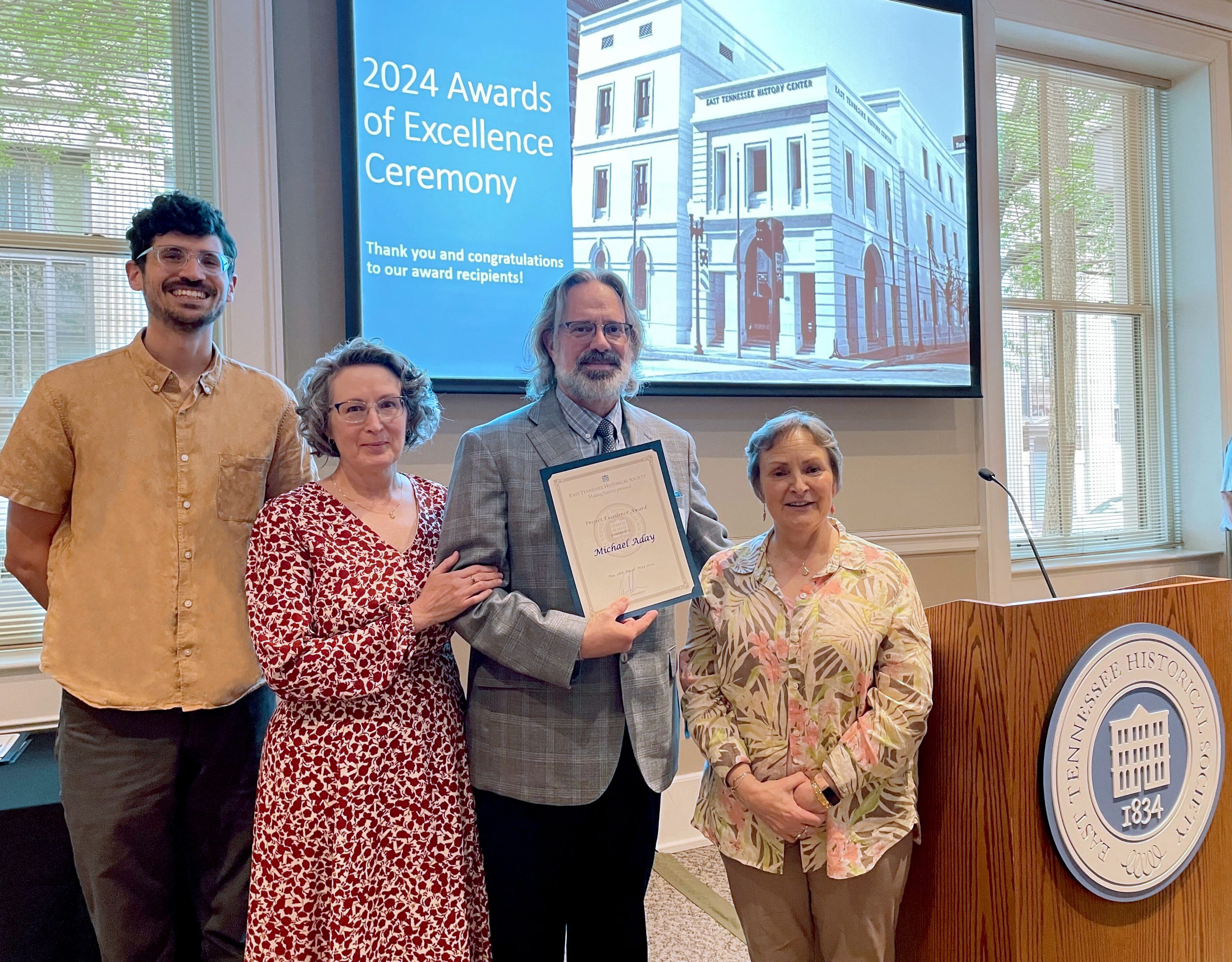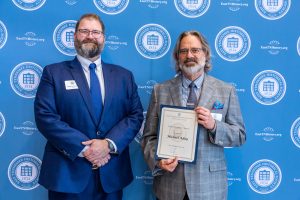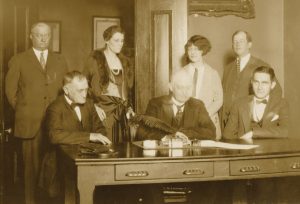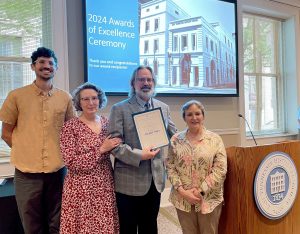

The ledger of a Waynesville liquor retailer. A letter about harp singing and squirrel stew. Limericks crafted amid a sub-zero blizzard.
These may seem an unlikely collection of plot points to tell the story of Great Smoky Mountains National Park, but for Michael Aday, the park’s librarian and archivist, they stood out from the 1.4 million records in the park’s archival collection enough to earn inclusion in his book Letters from the Smokies, published last fall by Smokies Life.
“I wanted people to learn things they might not know about the park,” he said, and by that metric he succeeded. “Even people who fancy themselves experts learned a couple things.”
Aday was pleased by the book’s reception and surprised when it earned recognition from the East Tennessee Historical Society. On May 18, he received a 2024 Project Excellence Award for contributions to preserving and promoting the region’s history. The “unique and personal glimpse” the book offers into the lives of past mountain residents attracted the organization’s attention, said Director of Administration Stephanie Henry.
“Focusing on historical correspondence, the book provides primary source documentation that greatly adds to our study and understanding of Great Smoky Mountains National Park and those who have called it home,” she said.

“I’m still a little shocked by it,” Aday admitted. “It’s not something I ever thought I’d receive, especially on my first book.”
Smokies Life CEO Laurel Rematore said she was “thrilled” but not shocked.
“Letters from the Smokies is an achievement of historical storytelling that plays well to Aday’s unique insights and intimate familiarity with the collections at Great Smoky Mountains National Park as its archivist and librarian,” she said. “From chapter to chapter and letter to letter, readers are guided through regional history, introduced to new heroes, and reacquainted with the incredible efforts it took to preserve the national park we all enjoy today.”
Like his readers, Aday learned a great deal about the history of the park he serves as he worked through the book.
“One of the things that I discovered was the African American history in the park and in the region,” he said. “I didn’t really know what the level of community involvement was with the plan to establish the park.”

That involvement is discussed in a chapter showcasing a pair of March 1926 letters from A.A. Felding, a Black real estate agent and political leader in Knoxville, to David Chapman, who was then director of the Great Smoky Mountains Conservation Association. In the first letter, Felding asked Chapman for a list of “subscriptions turned in by colored people” to support the park effort. In the second, he pledged $300 to “about double” the amount raised by his fellow Black citizens.
Aday also discovered some unlikely heroes. Possibly his favorite story in the book is that of Deborah McGee. What we know of McGee’s life comes from the pages of the ledger she kept at her business in Waynesville and government documents such as her will, federal liquor license, and census records. Born in Tennessee around 1810, she came to own about 125 acres of land in the state by 1841. Shortly thereafter, she moved to Waynesville, North Carolina, where she married John McGee. When John died years later in 1856, Deborah forged her own path, which was not an easy feat given the circumstances. Although records indicate she did not have any children of her own, she was still responsible for her younger sister Elizabeth, who was described as “crippled for life” in the 1860 census. From 1860 to 1880, Deborah operated a successful inn or tavern in Waynesville, and in 1869 she received a federal license to make and sell liquor. Both were profoundly unusual endeavors for a woman at the time.
“I have this image of her in my head, but I’d love to see a photo,” Aday said. “I’d love to know where her retail location was. I’d like to know a lot more about her.”
Some storylines were more predictable.
“Something that didn’t surprise me was the level of controversy surrounding some of the park management decisions, particularly the bear management program,” Aday said.

The last chapter of the book details the drama that unfolded in 1968 when word got out about the park’s plan to reduce human–bear conflicts. It centers on a pair of postcards sent to the then superintendent George Fry. “We don’t want you any longer, we much prefer the bear, they are not half as dangerous,” one said. The second was addressed to “Dear Jackass Fry.”
The letters came after the Knoxville News-Sentinel reported that the park planned on “removing bears on first appearance” at several high-traffic locations—and hitting them with clubs to instill a fear of humans. The article did not clarify that only bears seeking human food would be removed from the park, and though the plan did call for aversion therapy tactics to deter the bears, no specific methods were prescribed—it’s unclear where the notion of hitting them with clubs came from.
“Interestingly, the News-Sentinel piece was written by Georgianna Fry, daughter of Superintendent Fry,” Aday wrote. “Could an off-hand comment at home have made it into the published story and created a colossal misunderstanding?”
Not everything in the park archives is made of ink and paper. One of Aday’s favorite 3D items makes an appearance in the book—the ostrich-quill feather that Tennessee Governor Austin Peay used to sign legislation purchasing land owned by the Little River Company, a critical step toward the park’s creation. The pen, visible in a photo of the signing, was later gifted to Anne M. Davis, whose election in 1925 made her Tennessee’s third-ever female state representative. Her desire to preserve the Smokies as a national park, conceived after returning from a 1923 trip to Yellowstone National Park, inspired her to run for office.

“I remarked that I thought the Great Smokies were as beautiful as any mountains we had seen in the west and I thought that with so many parks in the west there should be one in the east,” she wrote in a note reprinted in the book.
Smokies history is not an isolated topic—it’s intimately connected to the larger history of America. The creation of the Smokies unfolded along with the rise of the conservation movement that protected natural wonders across the country, and though the logging industry that predated the national park devastated the environment there, it also fueled expansion and economic growth in places far removed from Southern Appalachia.
“It’s just all so intricately tied together,” Aday said. “It’s very difficult to unpick all of the little strands that go together to make the history of the Smokies and Southern Appalachia integral to the history of the rest of the country.”
Letters from the Smokies helps unknot the tangle, one long-forgotten document at a time.
Subscribe to get the latest posts sent to your email.
The Great Smokies Welcome Center is located on U.S. 321 in Townsend, TN, 2 miles from the west entrance to Great Smoky Mountains National Park. Visitors can get information about things to see and do in and around the national park and shop from a wide selection of books, gifts, and other Smokies merchandise. Daily, weekly, and annual parking tags for the national park are also available.